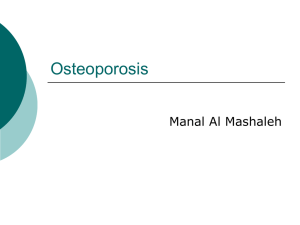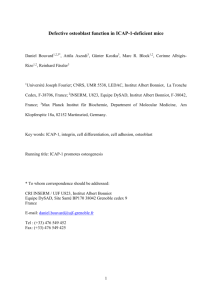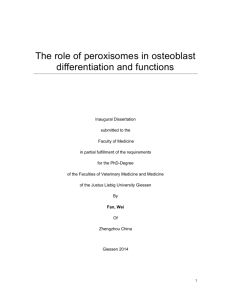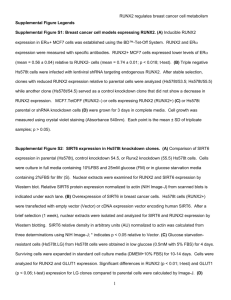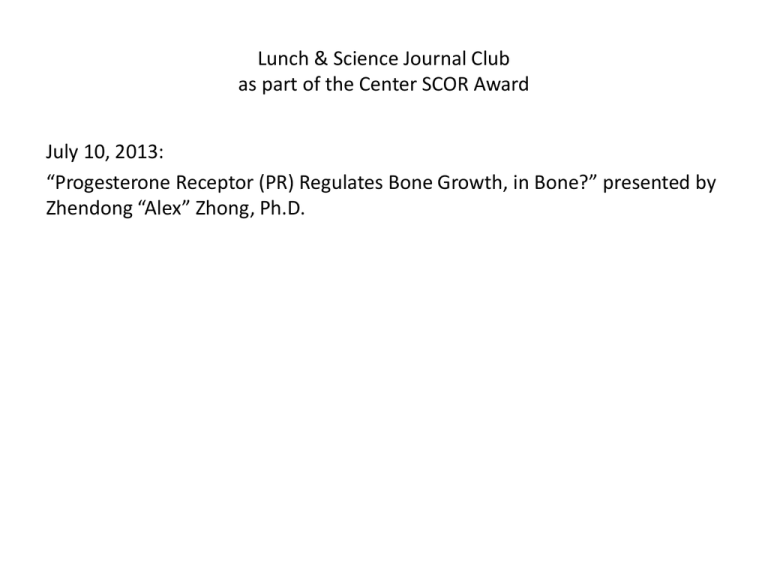
Lunch & Science Journal Club
as part of the Center SCOR Award
July 10, 2013:
“Progesterone Receptor (PR) Regulates Bone Growth, in Bone?” presented by
Zhendong “Alex” Zhong, Ph.D.
Peak bone mass (PBM) predicts osteoporosis
Peak bone mass (PBM)
arthrolink.com
Estrogen
deficiency
Sex hormones for bone homeostasis
Gonads
Sex steroids
Testis
Androgens
Ovary
Estrogens
Increase Osteoblast
proliferation and differentiation
apoptosis
Activity &
apoptosis
?
Ovary
or
Adrenal glands
Progesterone
osteoclast
osteoblast
Progesterone affects other sex hormones profoundly
Wikipedia
Progesterone Receptor (PR)
Progesterone
Female menstrual cycle (cyclical)
Pregnancy (high, supports gestation)
Embryogenesis
Others (bone?)
Susan A. Leonhardt and Dean P. Edwards 2002
PR knockout (PRKO) mice show higher bone mass
BV/TV
• More dramatic HBM phenotype in females
• Higher Osteoblast maturation-related
genes, and lower apoptosis-related
• Higher bone formation rate in females,
lower bone resorption rate in males
• PR antagonist RU486 also enhanced
bone formation in normal female mice
Yao, PLoSONE, 2010
Further questions
High bone mass
in PRKO mice
?
1. Which cell population is responsible?
2. Which downstream signaling pathway of PR
is responsible?
3. What is the mechanism of the sex
differences?
4. The timing of PR knockout
Hypothesis
1. PR regulates bone homeostasis within bone
2. The regulation has sex differences
Specific aims
Aim 1.
To investigate the direct effects of PR deletion in osteoblasts on
bone formation, and compare these effects in female and male
mice
Aim 2.
To determine time-dependent and tissue-specific PR inhibition
on bone turnover and bone mass accrual
Bone Cell Differentiation
Hematopoietic
stem cell
TRAP-Cre
CtsK-Cre
Mesenchymal
Stem cell
Adipocyte;
myocyte;
MSC
neuron
Col10α1-Cre
Osx1-Cre
Sox9+
Col2α1+
Chondrocyte
Skeletal
progenitor
Sox9+
Runx2+ ??
Skeletal
primordium
Prx1-Cre
Osteoclast
Runx2+
ColXα1+
Hypertrophic
chondrocyte
Col2α1+
Runx2+
Osx1+
Oc+
Osteoblast
progenitor
Osteoblast
precursor
Osteoblast
precursor
Osteoblast
Dermo1-Cre Col2α1-Cre
Sox9-Cre
Col1α1-Cre (3.6kb)
Oc-Cre
CapG+
Dmp1+
SOST+
FGF23+
ORP150
Mineralizing
osteocyte
Mature
osteocyte
Dmp1-Cre
Osx1-Cre
Col1α1-Cre (2.3kb)
Mx1-Cre
Figure adapted from Bonewald,2011, Vankoevering, 2008 and Rodda, S. J. 2006
Generation of an inducible & bone-specific knockout of PR
1. Mx1-Cre
Osteoprogenitors
X
PR-flox/flox
2. Col1a1-CreERT2
Mature osteoblasts
Cre-Tg/+
X
Tg/+, flox/+
Induce
X
Tg/+, flox/flox
More tg/+, flox/flox
+/+, flox/flox
pI-pC or
Tamoxifen PR is knocked out in
“osteoprogenitors”
or “mature osteoblasts”
Mx1-Cre;PR-flox heterozygotes
Tg, flox/+, Female
pI-pC IP injection starts at 1 month of age
Bone volume (white) / Total volume (BV/TV)
wt
PRKO
TV
2.70
2.41
BV
0.20
0.61
3mo, Female
TV/BV
0.08
0.25
Challenges
• To induce PR gene knockout after 1 month of age
Col1a1-CreERT2 does not respond well to Tamoxifen induction after 2 weeks of age
•
How well is Cre activated in different compartments?
Background activity? Specificities?
Determine the knockout efficiency using mT/mG model
“mT/mG”
Stop codon
tdTomato
loxP
loxP
Stop codon
EGFP
×
Col1a1-CreERT2
or Mx1-Cre
ATG
Mx1-Cre; mTmG mice
Cell Stem Cell, 2012
Mx1-Cre;mTmG mice, induced in vivo at 4 weeks of age
Bright field
Green: GFP /Mx1 activity
Red: Tomato /all others
No induction
Osteoclastic differentiation
Blue: DAPI/nuclei
Mx1-Cre;
mTmG
Induced in vivo
Col1-Cre;
mTmG
Bone marrow cells from the femurs,
in vitro cultured for overnight
Mx1-Cre;mTmG mice, induced in vivo at 4 weeks of age
Bone marrow stromal cells were differentiated into osteoblasts, for 7 days
Non-induced
Induced
stromal cells were differentiated into osteoblasts
1. Mx1-Cre is active in a part of
osteoprogenitors before induction;
2. Mx1-Cre is harder to be activated in
mineralized osteocytes?
No differentiation
14d differentiation
Ex vivo study on PR signaling
control
Induced
(Mx1-Cre)
Mx1/Col1-Cre; PR-flox
PR protein
Bone growth
Induced
(Col1-Cre)
Osteoblast differentiation,
TGFβ/IHH/Wnt signaling changes
Summary
• Generated conditional/inducible PR knockout mice,
measuring bone mass changes post induction
• Investigating the timing and dosage for TM/pl-pC induction
Next steps
•
Measure bone mass in homozygotes
•
New models: Prx1-Cre/ Oc-Cre
•
Study Wnt/IHH/TGF pathways







